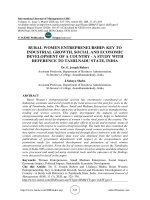Economic growth and economic development 558
Bạn đang xem bản rút gọn của tài liệu. Xem và tải ngay bản đầy đủ của tài liệu tại đây (65.14 KB, 1 trang )
Introduction to Modern Economic Growth
by Griliches and Schmookler (1963), and most forcefully by Schmookler’s seminal
study, Invention and Economic Growth. Schmookler writes:
“...invention is largely an economic activity which, like other economic
activities, is pursued for gain.” (1966, p. 206)
Moreover, Schmookler argues against the importance of major breakthroughs
in science on economic innovation. He concludes his analysis of innovations in
petroleum refining, papermaking, railroading, and farming by stating that there
is no evidence that past breakthroughs have been the major factor in new innovations. In particular, he argues: “Instead, in hundreds of cases the stimulus was the
recognition of a costly problem to be solved or a potentially profitable opportunity
to be seized...” (1966, p. 199). Other studies of innovation in particular industries also reach similar conclusions, see, for example, Myers and Marquis (1969) or
Langrish et al. (1974).
A main determinant of profitability of new innovations is the market size for
the resulting product or technology. A greater market size increases profits and
makes innovation and invention more desirable. To emphasize this point, Schmookler called two of his chapters “The amount of invention is governed by the extent of
the market.” Schmokler’s argument is most clearly illustrated by the example the
horseshoe. He documented that there was a very high rate of innovation throughout
the late nineteenth and early twentieth centuries in the ancient technology of horseshoe making, and no tendency for inventors to run out of additional improvements.
On the contrary, inventions and patents increased because demand for horseshoes
was high. Innovations came to an end only when “the steam traction engine and,
later, internal combustion engine began to displace the horse...” (1966, p. 93). The
classic study by Griliches (1957) on the spread of hybrid seed corn in the U.S. agriculture also provides support for the view that technological change and technology
adoption are closely linked to profitability and market size.
A variety of more recent papers also reach similar conclusions. An interesting
paper by Newell, Jaffee and Stavins (1999) shows that between 1960 and 1980, the
typical air-conditioner sold at Sears became significantly cheaper, but not much more
energy-efficient. On the other hand, between 1980 and 1990, there was little change
544









